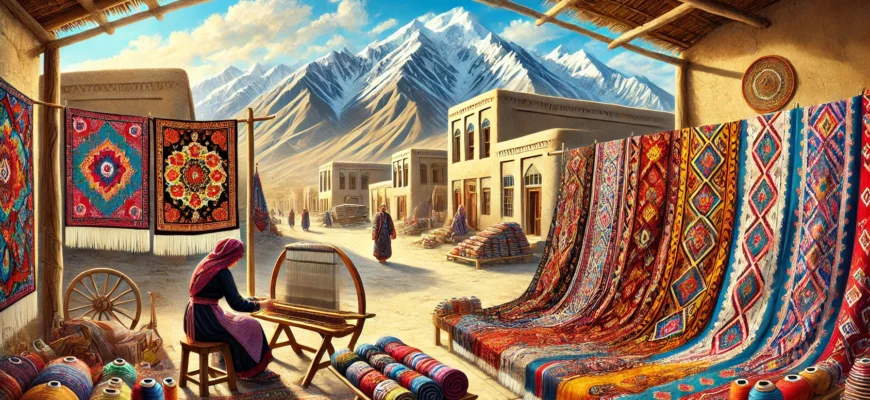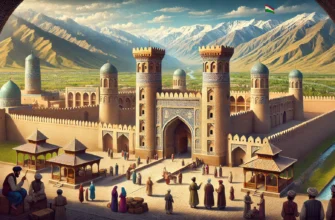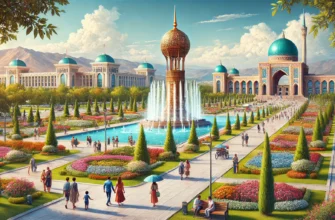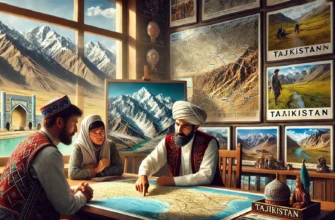Nestled in the heart of Central Asia, Tajikistan is a land of mesmerizing landscapes and captivating history that has long piqued the curiosity of adventurers and historians alike. From the towering peaks of the Pamir Mountains to the tranquil waters of Iskanderkul Lake, Tajikistan’s natural beauty serves as a majestic backdrop to its rich cultural tapestry. Yet, the allure of this country extends beyond its scenery, inviting travelers to delve into a storied past shaped by ancient trade routes and vibrant cities.
Historically, Tajikistan holds a unique position as a crucial link on the legendary Silk Road, where traders and explorers once traversed, leaving behind a legacy marked by the ruins of Penjikent and the formidable Hissar Fortress. Its cities, such as Dushanbe and Khujand, offer a blend of historical depth and cultural vitality that reveal the complexities of Tajik identity. Within these urban centers lies a weave of traditions, languages, and festivals that shed light on the country’s ethnic diversity and cultural opulence.
To truly appreciate Tajikistan is to explore its iconic routes, like the renowned Pamir Highway, and experience the stunning architectural contrasts from Soviet-influenced structures to traditional Tajik styles. This article embarks on a journey through Tajikistan’s multifaceted history, uncovering the stories of its landscapes, cities, and people, while also inviting thrill-seekers to discover the outdoor adventures that await amidst its rugged terrain.
Natural Landscapes
Tajikistan is a nation defined by its breathtaking natural landscapes, with over 93% of its terrain covered by mountains. These spectacular peaks belong to the Tien Shan, Pamir, and Gissaro-Alai ranges, creating a predominantly mountainous region that captivates all who visit. The country boasts some of the most striking peaks in the world, including the towering Ismoil Somoni Peak in the Pamir Mountains, which rises to 7,495 meters. This rugged landscape is interspersed with over 1,000 glaciers, the largest being the Fedchenko Glacier. In summer, meadows burst into color with wildflowers like irises and poppies, making the region’s natural beauty unforgettable. Tajikistan’s landscapes are beautifully preserved, showcasing a blend of majestic mountains, clear lakes, and rich wildlife.
The Majestic Pamir Mountains
Known as the Roof of the World, the Pamir Mountains are an iconic symbol of Tajikistan’s natural splendor. These towering peaks, some rising to over 7,000 meters, are central to the area known as the Pamir Knot. The Pamir Mountains form part of the Tajik National Park, a UNESCO World Heritage site renowned for its breathtaking high-altitude scenery. This mountain range is not only a visual delight but also a historical wonder. The Pamir Highway, winding through these peaks, follows part of the ancient Silk Road, inviting adventurers to traverse its challenging paths. The Pamir region is rich in cultural history, home to the Pamiri people whose traditions and art reflect a deep bond with these ancient hills.
Iskanderkul Lake: A Scenic Retreat
Nestled in the Fasht River Valley, Iskanderkul Lake is a jewel among Tajikistan’s alpine lakes. The lake’s clear turquoise waters make it an ideal place for those looking to enjoy peaceful natural surroundings. Named after Alexander the Great—Iskander is the Persian name for Alexander—the lake is tied to many legends about his passage through the region. Visitors flock to experience this serene environment, surrounded by stunning peaks and vibrant flora. The area is a perfect spot for picnics, leisurely hikes, and nature photography, making it an unforgettable retreat from the hustle and bustle of daily life.
Varzob Gorge and Its Attractions
Varzob Gorge is a captivating natural attraction, offering a diverse landscape of high mountains, rough rivers, and deep gorges. This area is famous for its impressive glaciers and pristine lakes, which provide breathtaking views and fresh, pure water. The alpine meadows in Varzob Gorge attract hikers and travelers with their lush greenery, making the area a favorite for outdoor enthusiasts. Adventure seekers and professional alpinists find the gorge’s rugged terrain ideal for biking and hiking. This scenic backdrop combines natural beauty with numerous opportunities for recreation, ensuring a memorable experience for all who venture into this remarkable part of Tajikistan.
Historical Significance
Tajikistan is steeped in history, having been inhabited for over 4,000 years. Its earliest recorded history dates back to when it was part of the Achaemenid Empire around 500 BC. The region’s significance grew due to its strategic location on the Silk Road, which made it a key trading hub connecting China with the Western World. Over the centuries, the territory saw various rulers, including the Persian, Greco-Bactrian, and Saminid empires. This rich history has notably influenced the cultural and historical identity of modern-day Tajikistan. Among its notable ancient sites is the city of Penjikent, a hub of Buddhism and Zoroastrianism, which was destroyed in the 8th century and now stands as a UNESCO World Heritage Site.
The Silk Road Heritage
Tajikistan played a vital role in the ancient Silk Road, connecting significant trade routes that linked Bactria, Tokharistan, Soghd, and more to India, Afghanistan, and China. From the 5th to the 12th century, Tajikistan was integral to three main Silk Road paths: the Sogdian route, the Karategin route, and the Pamir route. These routes facilitated major cultural and commercial exchanges between the East and West. Due to this, Tajikistan became known for its high-quality silk production, passing down techniques through generations. The cultural heritage of the country, including its art and architecture, bears the stamp of diverse influences that traversed these famed trade routes, leaving a lasting legacy.
Ancient Ruins of Penjikent
Founded in the 5th century AD, Penjikent was the cultural soul of the Sogdian civilization. It flourished as a busy trading hub on the Silk Road, enabling cultural and economic exchanges. Archaeological efforts have uncovered frescoes and artifacts that highlight a rich pre-Islamic culture. The city fell during the Arab invasion in the 8th century, leading to its abandonment. Today, a museum at the site preserves its history, with remains of residential buildings, a necropolis, and a palace adorned with wall paintings. These ruins offer a vivid insight into the vibrant life and long history of the once-thriving ancient city.
Exploring Hissar Fortress
The Hissar Fortress stands as a testament to Tajikistan’s deep-rooted history, with its origins tracing back over 2,500 years. On a strategic hilltop, this fortress was once a crucial stronghold, securing paths along the Great Silk Road. The site has hosted human settlements dating back about 5,000 years, reflecting its enduring importance over millennia. The fortress as seen today, largely from the 16th century, underwent restoration during the mid-20th century. Historically, it was a bustling center, surrounded by mosques and madrasahs. Now, Hissar Fortress represents an impressive archaeological site, symbolizing Tajikistan’s rich cultural heritage and historical significance.
Vibrant Cities
Tajikistan is home to dynamic and culturally rich cities that tell stories of its past and showcase its progress. These cities, with their bustling markets, historical sites, and modern attractions, offer glimpses into both ancient traditions and contemporary life. Exploring vibrant cities such as Dushanbe and Khujand illuminates the unique blend of cultural influences that color this Central Asian country.
Dushanbe: The Cultural Hub
Dushanbe, the capital city of Tajikistan, has evolved from a simple Monday marketplace into a vibrant hub of culture and politics. It offers a blend of modern architecture and traditional elements, reflecting the city’s historical layers. As the largest city in Tajikistan, Dushanbe is rich in cultural events with numerous theaters and concert venues. The city showcases one of the world’s tallest flagpoles, standing 164 meters high in Friendship Square. Visitors can immerse themselves in the city’s colorful life by exploring local restaurants and parks, which contribute to Dushanbe’s charm and appeal. Despite being the most expensive city in Tajikistan, it remains considerably cheaper than other global capitals, making it an attractive destination for tourists.
Khujand and Its Historical Depths
Khujand is one of the oldest cities in Central Asia and is laden with historical significance. Many historians believe that it is the site of Alexandria Kraine, built by Alexander the Great. While only ancient structural remains survive, they offer meaningful insight into the city’s past. The Mausoleum of Sheikh Muslihiddin, dating back to the 16th century, is a vital historical and religious landmark in Khujand. The Panjshanbe Bazaar, the largest market in Tajikistan, delights visitors with its vibrant display of local produce and goods. Khujand’s historical landmarks, including the mausoleum and an old fortress, play a significant role in preserving its cultural heritage. Its proximity to archaeological sites such as Sarazm and Penjikent underscores Khujand’s place within the wider historical fabric of early Central Asian civilizations.
Cultural Richness
Tajikistan brims with cultural richness. It stands at the crossroads of major civilizations. This nation is renowned for its blend of historical influences and traditions. Tajikistan’s cultural fabric is woven through its ethnic diversity and rich traditions, languages that echo the region’s history, vibrant festivals, and aromatic cuisine. Ancient cities, like Penjikent, add layers to the cultural narrative. The traditional lifestyle and customs of its people, deeply connected to the land, further enhance the country’s cultural tapestry. Engaging with Tajikistan’s culture is a journey through time, showcasing its profound character and enduring legacy.
Ethnic Diversity and Traditions
Tajikistan’s ethnic diversity is a significant part of its identity. Over four-fifths of the nation is ethnically Tajik, a group known for being traditionally sedentary. They speak Tajik, a language close to Persian, which highlights the deep cultural ties. Historically, the region has been a melting pot, shaped by interactions with various civilizations. Silk production remains a vibrant industry, utilizing age-old methods, exemplifying the country’s rich cultural heritage. Penjikent, an ancient city, stands as a testament to the diverse influences of Buddhism and Zoroastrianism. Today, it is honored as a UNESCO World Heritage Site, celebrating the enduring cultural traditions of Tajikistan.
Languages of Tajikistan
Languages in Tajikistan reflect its rich historical tapestry. Tajik, the official language, belongs to the southwest group of Iranian languages. Unlike its Persian kin, it is written in the Cyrillic script. Russian also holds a special place as the language of interethnic dialogue, aiding in administration and business. Although not commonly spoken natively, its presence is felt throughout the nation. In the mountainous regions, various local languages echo the area’s diverse history. Uzbek is another prominent language, differing in script from that used in Uzbekistan. These languages bind the nation together, fostering communication across different cultural landscapes.
National Festivals and Celebrations
Tajikistan’s festivals are a vivid expression of its cultural vitality. Navrūz, celebrated on March 21, marks the New Year in sync with ancient Persian customs. This festival symbolizes nature’s renewal and is a moment of joyous community celebration. International Women’s Day stands out as a national holiday, spotlighting achievements in fostering equality. Memorial Day, February 12, alongside Independence Day, September 9, highlights national historical milestones. Religious festivities such as Idi Ramazon and Idi Qurbon are deeply cherished, reflecting the country’s Islamic roots. Spring also ushers smaller festivals celebrating the bloom of snowdrops and tulips, adding a colorful touch to the cultural calendar.
Savoring Tajik Cuisine
Tajik cuisine offers a delightful culinary adventure. With its roots entwined in Uzbek, Afghan, Russian, and Iranian flavors, the food here is a treat for the senses. Dishes like kabuli pulao and samanu reflect this rich heritage, with plov standing out as a beloved national dish. Traditional meals often start with dried fruits, nuts, and halva before moving to more substantial courses. Dishes made with lamb, goat, and horse meat are typical, reflecting the semi-nomadic traditions of the Tajiks. The diversity in pilaf recipes—over 400 ways to prepare it—highlights the dish’s cultural importance. Dairy products and hearty soups also play a central role, capturing the essence of Tajik cuisine.
Iconic Routes and Road Trips
Tajikistan is a landlocked country in Central Asia, known for its dramatic landscapes and vibrant cultural heritage. Among these stunning landscapes are the majestic Pamir Mountains—a key feature of the country’s appeal to travelers. This mountainous region offers incredible routes for road trips, making it a destination for adventurers from all over the world. The road trips through Tajikistan provide a unique journey, combining history, culture, and unparalleled mountain scenery. This makes these routes popular among tourists seeking a blend of adventure and beauty.
The Pamir Highway: An Adventurer’s Dream
The Pamir Highway is one of the most significant routes connecting Dushanbe in Tajikistan with Osh in Kyrgyzstan. Spanning 1,300 kilometers, this highway offers an unforgettable experience for travelers. The route climbs through the towering Pamir Mountains, with the Ak-Baytal Pass being the highest point at 4,655 meters above sea level. The severe terrain and natural beauty of this route attract cyclists and motorcyclists from around the world, eager to embrace the challenge. A journey along the Pamir Highway typically takes about a week, with adventurers passing through remote villages and experiencing breathtaking views every day.
Scenic Drives and Remote Villages
The Pamir Highway provides a scenic drive that takes travelers through Tajikistan’s remote and breathtaking landscapes. Stretching over 1,300 kilometers, the route crosses the formidable Pamir Mountains and reaches its highest point at the Ak-Baytal Pass. As travelers navigate this route, they encounter charming towns and quaint villages that offer a glimpse into the unique cultures of the region. Due to the harsh weather conditions, areas such as the Yagnob Valley are only accessible for a part of the year, preserving rare languages and traditions. The Fann Mountains are also a highlight, where travelers can witness stunning views and experience local life in the villages nestled within the mountain range.
Unique Architecture
Tajikistan is a land of rich history and fascinating architecture. The ancient city of Penjikent is a key cultural landmark, showcasing ruins from a once-thriving center influenced by Buddhism and Zoroastrianism before it was destroyed in the 8th century. Another significant site is the Hissar Fortress and Mausoleum, which dates back to the 16th century. These monuments provide a glimpse into Tajikistan’s diverse past. Khujand adds to this historical tapestry with the Khujand Fortress, originally founded in the fifth century B.C. Among modern landmarks, the golden statue of Ismoil Somoni stands out. It honors the founder of the country and reflects Tajikistan’s architectural heritage. The Masjid Jami Mosque, which has welcomed worshipers since the 16th century, exemplifies the religious architecture seen across the nation.
Soviet Influence in Tajikist Borders
In the early 20th century, Soviet influence dramatically reshaped the borders and identity of Tajikistan. Initially, it was part of the Uzbek SSR. However, economic differences and population demographics led to its separation. Notably, the Soviet nationalities policy left historical cities like Samarkand and Bukhara as part of Uzbekistan, despite their deep historical connections with Tajikistan. This redrawing of boundaries was part of the Soviet strategy to manage various ethnic groups within its domain. By 1929, Tajikistan had become one of the autonomous Soviet Republics, marking a new chapter in its history. The capital city, Dushanbe, was transformed from a modest township into a bustling city by Soviet planners. This transformation reflected broader Soviet efforts to exert influence across Asian countries. The cultural impacts of Soviet rule are still felt in Tajikistan today, particularly seen in the resurgence of interest in its culture and politics during the late 1980s, fueled by glasnost policies.
Traditional Tajik Architectural Styles
Tajikistan’s architectural landscape is diverse, reflecting its rich historical influences. The country is home to medieval mosques and Soviet-style buildings, each representing a chapter in its past. Scattered throughout the nation are remnants of ancient cities that bear witness to Tajikistan’s historical significance. Traditional architectural styles in Tajikistan are often captured in the graceful mosques, sturdy castles, and sacred sanctuaries that pepper its cities. Some of the most notable architectural monuments include the impressive Hissar Fortress and Mausoleum. These structures hold historical importance, dating back to the 16th century. In cities like Khujand, visitors will find historical structures like the Khujand Fortress. This fortress, with origins tracing back to the fifth century B.C., provides insight into the region’s extensive history. These architectural marvels not only narrate the story of the past but also continue to shape the cultural heritage of Tajikistan.
Outdoor Adventures
Tajikistan is a paradise for outdoor adventure lovers, boasting a landscape dominated by the rugged Pamir and Fann Mountains. Given that 93% of the country is covered by mountains, it’s a haven for activities like mountaineering, trekking, and biking. The famous Pamir Highway offers thrilling routes favored by cyclists and drivers alike. Due to the climate in these mountainous regions, temperatures can drop to -20°C in winter, so proper preparation is key. Besides traditional hiking, Tajikistan also supports exciting activities like rock climbing, facilitated by both local and international alpine agencies. These organizations often organize seasonal tours, showcasing the country’s diverse terrain. You can also enjoy fishing, horseback riding, and camping around the numerous trails that wind through Tajikistan’s scenic landscapes.
Hiking and Trekking Opportunities
For hikers and trekkers, Tajikistan offers an array of breathtaking opportunities. The Fann Mountains, in the northwest, are a prime destination, featuring trails like the Seven Lakes path. This trail provides access to a series of dazzling, high-altitude lakes and is perfect for multi-day treks. On the other hand, the Pamir Mountains present trekkers with their unique and barren desert-like highlands. Such landscapes offer not only a challenge but also mesmerizing views. Trekking in these areas allows you to immerse yourself in the culture of local communities, such as the Kyrgyz people near Karakul Lake. Their warm hospitality offers a slice of authentic local life. Moreover, hikers can explore ancient ruins, remnants of past civilizations like the Zoroastrians. Sites such as Panjakent enrich the trek with historical and archaeological interest, blending natural beauty with cultural heritage.
Rafting and Water Sports
Tajikistan draws water sports enthusiasts with its numerous fast-flowing mountain rivers, perfect for rafting. This activity offers a thrilling adrenaline experience, combining adventurous water sports with the country’s stunning natural scenery. Rafting routes not only provide excitement but are also renowned for their picturesque, yet often inaccessible, terrains. Navigating these rivers, rafters are surrounded by breathtaking views of rugged cliffs and remote canyons. These stunning settings have transformed rafting into a top attraction for visitors seeking adventure. Tourists flock to Tajikistan every year, eager to tackle its stormy rivers and revel in the dynamic landscapes. Whether you are an expert rafter or a beginner looking for excitement, Tajikistan’s water sports promise unforgettable outdoor experiences amid truly awe-inspiring views.









